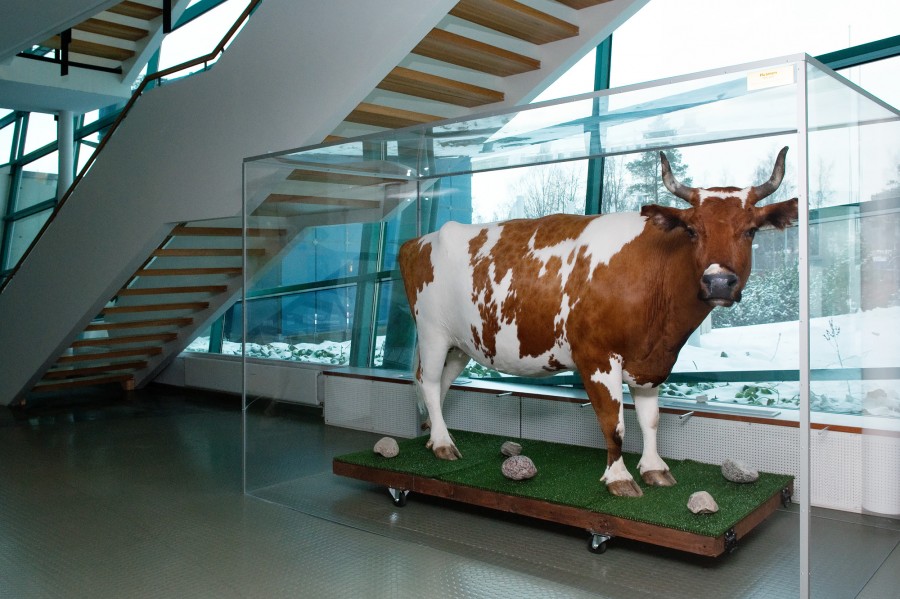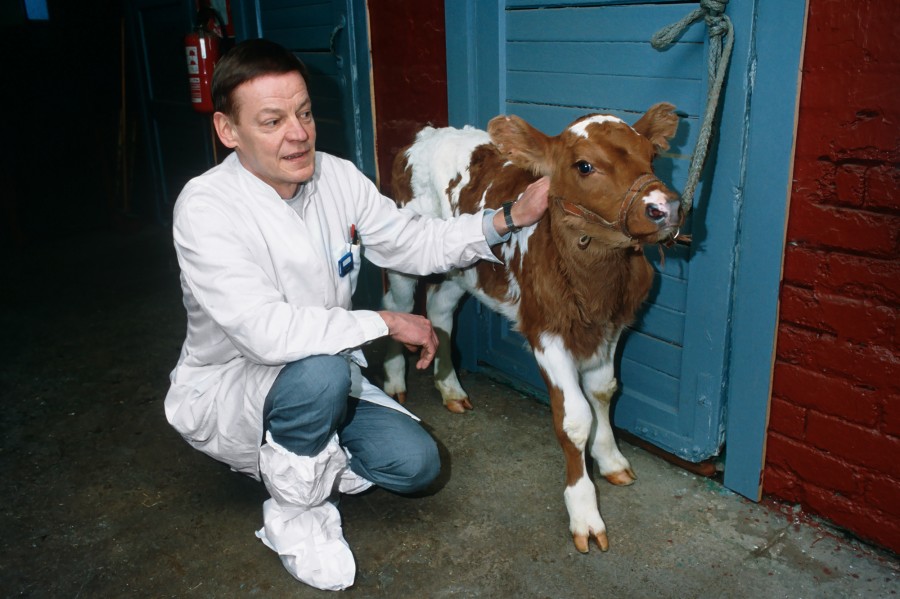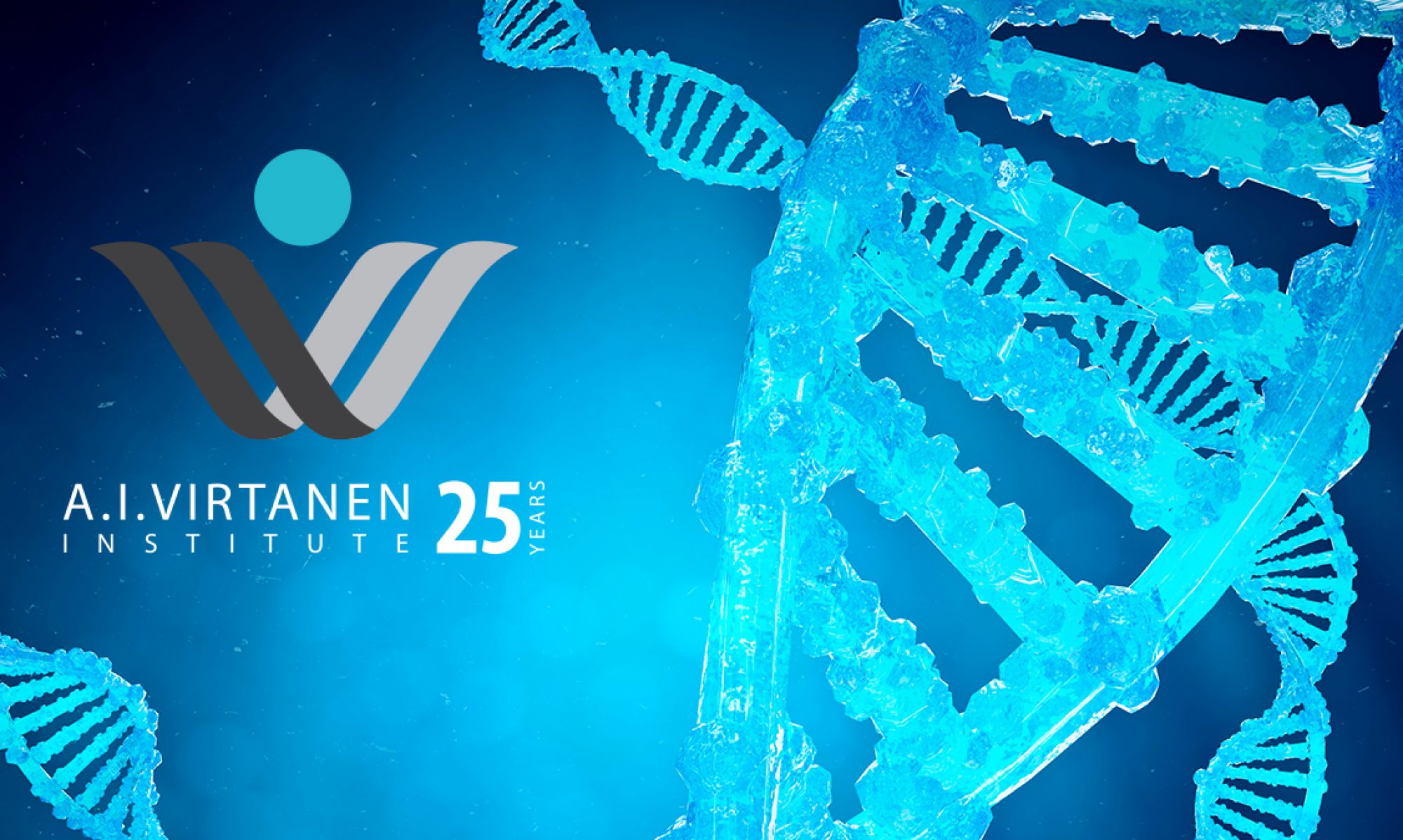Huomen (“Morn”) – transgenic cow
The text is a loosely translated excerpt from Kaija Vuorio’s book “Lentoon. Kuopion yliopiston neljä vuosikymmentä” (in English: Take-off. Four Decades of Kuopio University”) (2006).

Huomen (in English “Morn”), a calf of the cow called Aamu (in English “Morning”), was born on December 17, 1993. The father is known, the mother is not. Getting fat, aged and discontinued at just over eight years old on 27 August 2001. Got to the museum. Left his name in the history of science alongside his life tribesmen Tracy, Herman and Dolly. Aamu gave Huomen a name and a life. The genesis of the name is, in fact, quite prosaic, as the register had the letter H in turn and was the first to come to mind for the TV cameraman following the Caesarean section. The origins of the biological mother were even more prosaic. Huomen’s lineage originated from a cow ovary cell retrieved from a slaughterhouse’s guts heap. The father was Ayrshire. The paternal gametes originated from where all other stem bookcars, namely the local artificial insemination association. As an adult, Huomen looked like Ayrshire, though a little larger than usual, so it might have had some Frisian blood on the mother’s side.

Huomen was deservedly sensational at birth, a transgenic gender-defined bovine female, whose human hormone gene had been transferred to the lineage. The history of gene transfer for farm animals by then had been really short: the Tracy sheep in Scotland and the Herman bull in Holland a couple of years earlier. Huomen, however, was not a single phenomenon, but part of the chosen Kuopio biotechnology strategy. In 1988, Finland did not yet have the first transgenic animal, but soon the result began to come: transgenic mouse in 1990 and transgenic rat in 1992. All it needed now was to combine the knowledge of Professor Tapani Vanha-Perttula’s bovine embryonic research line with the gene expertise of Professor Juhani Jänne’s research group. Bovine embryo transplantation and gender assays were new techniques in Finland, let alone gene transfer methods. Before Huomen was born, 12,000 micro-injections, or gene transplantation, had been carried out in a fertilized egg, and 19 calves had been born for which gene transplantation had not been successful.
The remote goal was to utilize genetic technology in animal production. The erythropoietin (EPO) gene was transferred to Huomen and it would have been excreting this EPO hormone known to everyone after the Nordic World Ski Championships 2001 in Lahti. EPO is one of the most expensive drugs in the world, produced in mammalian cell cultures. The isolation of the hormone from milk was accompanied by high financial expectations. While Huomen basked in its fame into cow adulthood, research continued and the first transgenic rabbits saw the light of day in 1995. Mouse and rabbit tests ensured that EPO could enter the mammary gland into the bloodstream, increasing even at extremely low concentrations the number of red blood cells in the blood. Pregnancy would have meant Huomen’s blood clot risk, so it was never pregnant.
Huomen was allowed to remain a simple heifer and no longer expected to become worthy of the pulp mill, because the most interesting thing for biotechnology production was the knowledge of the pit. The first biotechnology company was FinnGene Ltd, with TeknologiakeskusTeknia, University Foundation, Savon Liitto and private researchers. Dutch Gene Pharming acquired FinnGene in 1995 and moved the company into its subsidiary under the name Pharming Ltd. The company built a test cow barn in Alapitkä, Lapinlahti, with a maximum of 80 transgenic cattle. The parent company’s difficulties brought down the subsidiary in 2001, too.
Huomne was allowed to live in the barn of Alapitkä for long life that it began to be ailments of old age. It did not reach pasture after the summer of 1995, as the Genetic Engineering Board banned it from grazing. As a genetically modified animal, it was practically perceived as a hazardous waste at the time of death, although the letter of law was not eventually found. That’s why it ended up at the Honkajoki animal waste treatment plant. Although scientifically, Huomen was only one milestone, it was of crucial importance for all Finnish life science research. It was a showcase not only for Kuopio scientists, but also for funding for Finnish biotech research. Its birth was a glimmer of light in the years of economic depression, and it is probably not quite a coincidence that the financial decisions of biotechnology were established around the time of its birth.
The research work leading up to Huomen brought Professor Juhani Jänne the prestigious Prize for Medicine “Matti Äyräpää” in 1994. The Huomen project also produced four dissertations and one book of fiction — Anja Siippainen’s novel “Kultainen vasikka” (in English the Golden Calf) in 1992.

